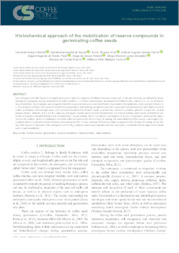Histochemical approach of the mobilization of reserve compounds in germinating coffee seeds.
Histochemical approach of the mobilization of reserve compounds in germinating coffee seeds.
Author(s): OLIVEIRA, L. A.; SOUZA, G. A. de; SILVA, B. T.; ROCHA, A. A. G.; PICOLI, E. A. de T.; PEREIRA, D. de S.; DONZELES, S. M. L.; RIBEIRO, M. de F.; FERREIRA, W. P. M.
Summary: The endosperm of coffee beans is an important structure which is composed of different reserve compounds. In the present work, we followed anatomical features during the reserve mobilization of Coffea Arabica L. 'Catuaí' seed samples, harvested at 20 different sites, after 0, 3, 6, 12, 24, 33 and 45 days of imbibition. Seed samples were properly fixed and stored, respectively, for histochemical and enzyme activity approach. Fixed samples were cross-sectioned for detection of starch, lipids, essential oils, oleoresins, proteins, phenolic compounds, neutral polysaccharides, alkaloids, B-1,3 and B-1,4 glucans, and lignin. Overall, based on histochemical tests and enzyme activity, seed reserve mobilization was similar among the evaluated altitudes and mountainsides. During soaking, there is an intense consumption of reserve compounds, starting at the region close to the embryo. Reserve mobilization intensifies after root protrusion, from 12 days of soaking. The intensification of the reserve consumption is concomitant with an increased activity of MDH is observed at the first 12 days, whereas SOD showed higher expression after 33 days of soaking. At the 33 rd day, little reserve is observed in the endosperm. At 45th day, cotyledon leaves are expanded, and the root system, constituted by the taproot and lateral roots, is well established.
Publication year: 2020
Types of publication: Journal article
Unit: Embrapa Coffee
Observation
Some of Embrapa's publications are published as ePub files. To read them, use or download one of the following free software options to your computer or mobile device. Android: Google Play Books; IOS: iBooks; Windows and Linux: Calibre.
Access other publications
Access the Agricultural Research Database (BDPA) to consult Embrapa's full library collection and records.
Visit Embrapa Bookstore to purchase books and other publications sold by Embrapa.

